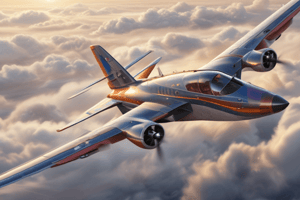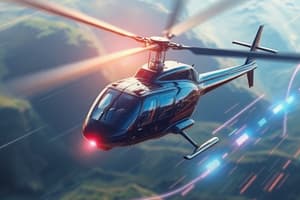Podcast
Questions and Answers
What is the primary concept that explains the relationship between air pressure and velocity in aerodynamics?
What is the primary concept that explains the relationship between air pressure and velocity in aerodynamics?
Bernoulli's principle
What type of drag is caused by air friction, and what is an example of it?
What type of drag is caused by air friction, and what is an example of it?
Frictional drag, caused by air friction, is an example of it. For instance, the drag created by the aircraft's fuselage.
What type of engine uses a turbine to compress air and generate thrust?
What type of engine uses a turbine to compress air and generate thrust?
Turbojet engine
What is the purpose of the curved surface on an airfoil, and what are its characteristics?
What is the purpose of the curved surface on an airfoil, and what are its characteristics?
What are the three primary control surfaces on an aircraft, and what are their functions?
What are the three primary control surfaces on an aircraft, and what are their functions?
What is the primary purpose of the electrical power generation system in an aircraft?
What is the primary purpose of the electrical power generation system in an aircraft?
Flashcards are hidden until you start studying
Study Notes
Aerodynamics
- Study of the interaction between air and solid objects, such as aircraft
- Involves understanding the properties of air, including density, viscosity, and compressibility
- Key concepts:
- Bernoulli's principle: relationship between air pressure and velocity
- Laminar and turbulent flow: smooth and chaotic air flow patterns
- Boundary layer: layer of air closest to the aircraft's surface
Lift and Drag
- Lift: upward force opposing weight, created by wing shape and airfoil design
- Depends on wing shape, angle of attack, and air density
- Increases with speed and angle of attack (up to a point)
- Drag: backward force opposing motion, created by air resistance
- Depends on air density, shape, and speed
- Types:
- Frictional drag: caused by air friction
- Form drag: caused by air displacement around the aircraft
Thrust and Propulsion
- Thrust: forward force propelling the aircraft
- Created by propellers, jet engines, or rockets
- Depends on engine power, propeller efficiency, and air density
- Propulsion systems:
- Reciprocating engines: use pistons and cylinders to generate power
- Turbojet engines: use turbine to compress air and generate thrust
- Turboprop engines: use turbine to drive propeller
Airfoil Design
- Airfoil: curved surface that produces lift when air flows over it
- Shapes:
- Symmetrical: equal curvature on top and bottom
- Asymmetrical: greater curvature on top
- Characteristics:
- Cambered: curved surface on top
- Flat bottom: flat surface on bottom
- Shapes:
Flight Control Systems
- Control surfaces: moveable surfaces that control aircraft attitude and direction
- Ailerons: move up and down to roll the aircraft
- Elevators: move up and down to pitch the aircraft
- Rudder: moves left and right to yaw the aircraft
- Flight control modes:
- Primary: direct control of control surfaces
- Secondary: indirect control through automation and computer systems
Aircraft Electrical Systems
- Electrical power generation:
- Alternators: convert mechanical energy to electrical energy
- Generators: convert mechanical energy to electrical energy
- Electrical distribution:
- Bus: main electrical distribution point
- Circuits: paths for electrical current
- Wiring: connects components to bus and circuits
- Protective devices:
- Fuses: protect against overcurrent
- Circuit breakers: protect against overcurrent and fault conditions
Aerodynamics
- Study of air interaction with solid objects, such as aircraft, involving air properties like density, viscosity, and compressibility
Key Concepts
- Bernoulli's principle: relationship between air pressure and velocity
- Laminar and turbulent flow: smooth and chaotic air flow patterns
- Boundary layer: layer of air closest to the aircraft's surface
Lift and Drag
Lift
- Upward force opposing weight, created by wing shape and airfoil design
- Depends on wing shape, angle of attack, and air density
- Increases with speed and angle of attack (up to a point)
Drag
- Backward force opposing motion, created by air resistance
- Depends on air density, shape, and speed
- Types:
- Frictional drag: caused by air friction
- Form drag: caused by air displacement around the aircraft
Thrust and Propulsion
Thrust
- Forward force propelling the aircraft
- Created by propellers, jet engines, or rockets
- Depends on engine power, propeller efficiency, and air density
Propulsion Systems
- Reciprocating engines: use pistons and cylinders to generate power
- Turbojet engines: use turbine to compress air and generate thrust
- Turboprop engines: use turbine to drive propeller
Airfoil Design
Airfoil
- Curved surface that produces lift when air flows over it
- Shapes:
- Symmetrical: equal curvature on top and bottom
- Asymmetrical: greater curvature on top
- Characteristics:
- Cambered: curved surface on top
- Flat bottom: flat surface on bottom
Flight Control Systems
Control Surfaces
- Moveable surfaces that control aircraft attitude and direction
- Ailerons: move up and down to roll the aircraft
- Elevators: move up and down to pitch the aircraft
- Rudder: moves left and right to yaw the aircraft
Flight Control Modes
- Primary: direct control of control surfaces
- Secondary: indirect control through automation and computer systems
Aircraft Electrical Systems
Electrical Power Generation
- Alternators: convert mechanical energy to electrical energy
- Generators: convert mechanical energy to electrical energy
Electrical Distribution
- Bus: main electrical distribution point
- Circuits: paths for electrical current
- Wiring: connects components to bus and circuits
Protective Devices
- Fuses: protect against overcurrent
- Circuit breakers: protect against overcurrent and fault conditions
Studying That Suits You
Use AI to generate personalized quizzes and flashcards to suit your learning preferences.




